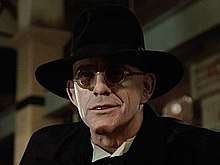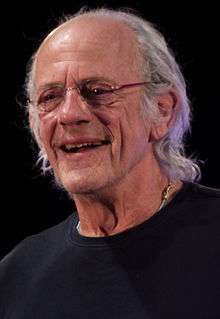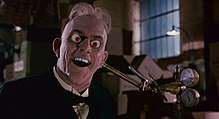Judge Doom
| Judge Doom | |
|---|---|
 | |
| First appearance | Who Framed Roger Rabbit (June 22, 1988) |
| Created by |
Jeffrey Price Peter Seaman |
| Portrayed by | Christopher Lloyd |
| Information | |
| Species |
Human (formerly) Human-Toon Hybrid (currently) |
| Gender | Male |
| Occupation | Judge |
Judge Doom is a fictional character portrayed by Christopher Lloyd in the 1988 motion picture Who Framed Roger Rabbit. He is depicted as a much feared, cruel and malicious judge of Toontown who is responsible for the framing of the titular character and the killing of Eddie Valiant's brother within the film.
Judge Doom is an original character from the script of the film created by screenwriters Jeffrey Price and Peter S. Seaman. Many actors were considered for the role of the character such as Tim Curry and Christopher Lee.
The reviews of Christopher Lloyd's role as Judge Doom were mostly positive. Judge Doom was ranked as one of the greatest film villains of all time by Wizard magazine and WhatCulture. Also the character and his plot twist reveal as a toon is placed as one of the scariest childhood moments, being ranked along characters like Large Marge from Pee-wee's Big Adventure and the Child Catcher from Chitty Chitty Bang Bang.
Judge Doom also appeared in video games, a graphic novel and a few merchandising items based on the film.
Appearances

When Who Framed Roger Rabbit first introduces Judge Doom, Lt. Santino confides to Eddie Valiant that Doom bought the election. Doom threatens himself as executioner to Roger Rabbit once he catches him with a new invention he created that combines a chemical vat of turpentine, acetone and benzene (paint thinners) he dubs "The Dip". Doom Shows off his invention by killing an animated anthropomorphic shoe in front of Eddie. Roger realizes he's in trouble with Doom after him, and begs Eddie to hide him. Later, at the Terminal Bar, Doom uses the "Shave and a Haircut" trick to lure Roger out, then prepares to execute him. After a brief scuffle inside the bar, the Judge orders the weasels to capture Roger and Eddie Valiant. When Eddie learns that studio head R.K. Maroon is connected to the plot to frame Roger, Eddie interrogates him, but Maroon pleads that he is "a dead man" if he confesses. Just as Maroon is about to spill everything, he is killed by an unseen gunman who nearly shoots Eddie as well.[1]
Upon chasing the killer to Toontown, Eddie catches Jessica Rabbit, thinking she's the murderer, but Jessica reveals that Judge Doom was the one who killed Acme and Maroon. At the film's climax, Doom traps Eddie, Jessica, and Roger in the Acme Factory to explain his scheme: Erase Toontown from the map using a giant, mobile vat of dip linked to a high-pressure water cannon, and then build a freeway over it. Doom then plans to retire from being a judge and control all the profits from the new road system. Doom also reveals that he is the sole shareholder of the Cloverleaf corporation, and confesses that he bought the trolley car company for the sole purpose of putting it out of production. He then orders Jessica and Roger to be tied up and raised into the air via skyhook to be sprayed by the dip cannon.[1]
Valiant distracts the weasels using hilarious antics to make them laugh themselves to death, then attempts to rescue Roger and Jessica when he is interrupted by Doom. The two men then square off, dueling with various ACME props. During the fight, Judge Doom is run over by a steamroller, but does not die as expected. As the steamroller crushes him, Doom's body is flattened into a flimsy paper-thin shape, revealing himself to be a Toon wearing an assortment of fake props such as fake eyeballs, false teeth and a rubber mask in order to disguise his Toon body. When Doom shows his red toon eyes and talks in a high squeaky voice, Eddie recognizes Doom as the bank robber in Toontown long ago who murdered his brother, Teddy Valiant, thus explaining how Doom managed to buy the judicial election and the trolley car company.[1]
Doom sprouts a cartoon anvil and an extendable toon buzzsaw from his hand, attempting to finish off Eddie. In the end, Eddie proves to be too clever for the evil Toon, dissolving him by using his own dip concoction against him and leaving behind his human disguise. A crowd of various Toons then surround his empty suit and wonder what kind of Toon he was. It hasn't been revealed what type of Toon he was, or if he was one specific type of Toon at all. The Toons seem to agree that they don't need to know, and decide to live happily ever after when the will of Marvin Acme suddenly appears in Roger's possession, granting full ownership to the citizens of Toontown.[1]
Judge Doom appears as a final boss in the 1988 video game adaption,[2] the 1989 video game adaption,[3] and the 1991 video game adaption of the film.[4]
In the graphic novel Roger Rabbit: The Resurrection of Doom, it is explained that Doom was originally, a toon named Baron von Rotten, who took up the role of playing the antagonist in movies, until an accident in which Von Rotten suffers a concussion, and awakens believing he is a real villain. Von Rotten thus begins his crime career, robbing the First National Bank of Toontown, then killing Theodore 'Teddy' Valiant by dropping a piano on his head, and spreading the stolen money all over the town in order to buy the election for Judge of Toon Town, assuming the new name of Judge Doom.[5]
Characterization
In Who Framed Roger Rabbit (as depicted by Christopher Lloyd) he is the much-feared Judge of Toontown. Despite presiding over a city of Toons, Doom is totally without mirth and passes capital punishment on Toons who break the law, placing them in a chemical vat of turpentine, acetone and benzene which he dubs "The Dip". The Judge employs Toon henchmen (the "Toon Patrol") to assist him in hunting down Roger Rabbit for the murder of Marvin Acme.[1]
Doom wears a black ensemble which includes a caped overcoat, a fedora, gloves, and rimless yellow-tinted glasses; he also carries a pocketwatch, as well as a cane which is revealed to be a saber in disguise, for use in emergency situations.[1]
Concept and creation
.jpg)
During the writing process, Jeffrey Price and Peter S. Seaman were unsure of whom to include as the villain in the plot of Who Framed Roger Rabbit. They wrote scripts that had either Jessica Rabbit or Baby Herman as the villain, but they made their final decision with newly created character Judge Doom. Price and Seaman based the scheme of Judge Doom of destroying Toontown for a freeway by a planned unproduced sequel of Chinatown entitled Cloverleaf which would be the name of Judge Doom's company in the film.[6] Doom was supposed to have an animated vulture sit on his shoulder, but this was deleted due to the technical challenges this posed.[7] Doom would also have a suitcase of 12 small animated kangaroos that act as a jury, by having their joeys pop out of their pouches, each with letters, when put together would spell YOU ARE GUILTY. This was also cut.[8] Doom was originally the hunter who killed Bambi's mother.[8]
Tim Curry originally auditioned for the role of Judge Doom, but after his audition, the producers found him too terrifying for the role.[9] Christopher Lee was also considered for the role, but turned it down.[10] Several other actors were also considered for the role of Judge Doom, including John Cleese, Roddy McDowall, Eddie Deezen, and Sting.[10]
Christopher Lloyd was cast because he previously worked with Robert Zemeckis and Amblin Entertainment on Back to the Future in his most famous role as Emmett Brown. Lloyd compared his part as Doom to his previous role as the Klingon commander Kruge in Star Trek III: The Search for Spock, both being overly evil characters which he considered being "fun to play".[11] Lloyd avoided blinking his eyes while on camera to perfectly portray the character.[7]
Merchandising
LJN released film merchandise of the character with the pet vulture that was scrapped during production.[6] Doom and Eddie Valiant were both playable characters in the action board game Who Framed Roger Rabbit:. Dip Flip by LJN. In the game one player plays Judge Doom to dip as many toons as they can while another player plays Eddie Valiant trying to save the toons.[12] A Funko action figure of Judge Doom with his animated eyes along with him holding the anthropomorphic shoe that he dips in Who Framed Roger Rabbit was released by Walt Disney Company as part of the Roger Rabbit lineup.[13]
Cultural impact
Film director Robert Zemeckis compared Judge Doom's invention of "the dip" to eliminate all the toons as Hitler's Final Solution.[17] While a fictional character, Judge Doom's scheme is ultimately based on the development of the existing Southern California freeways.[18] The film is set in 1947 where Judge Doom plans to destroy Toontown over building a freeway and buy off the Pacific Electric railway to dismantle it. According to him it will boost automotive businesses which indeed it did in real life.[19] This scheme has been cited as a metaphor behind the history of automobiles and the economy of the technological age by various authors such as James Howard Kunstler in the book The Geography of Nowhere.[20][21][22]
Christopher Lloyd received praise for his portrayal of Doom by film critics.[23] [24] Wizard magazine rated Doom as the 60th Greatest Villain of All Time.[25] He was placed as number nine as the creepiest film villain in the 1980's by WhatCulture.[26] WhatCulture also placed him as the fifty second greatest film villain of all time.[27] Digital Spy placed him as one of the most “batshit” film villains of all time.[28] Fandango placed him number one on their list of "the most nefarious live-action Disney villains".[29]
The film's plot twist of him being revealed as a toon was usually ranked as the scariest of scenes for "kids films". It is usually ranked along with characters such as Large Marge from Pee-wee's Big Adventure and the Child Catcher from Chitty Chitty Bang Bang.[15][14] His reveal as a toon character was placed as one of the most traumatizing reveals for kids from the 1980s by BuzzFeed.[15] While Rolling Stone placed it as one of the top twelve of scariest moments in a "kids" film.[14] Neal Justin of the Star Tribune described Judge Doom as making Freddy Krueger "look like Fred Rogers".[30] YouTuber Nostalgia Critic placed this scene reveal as number three of his "Top 11 Scariest Nostalgic Moments".[31]
Christopher Lloyd responded to the character he played:
Doom was such a dark character. I've had so many people come up to me over the years to tell me that when they were kids that movie scared the hell out of them — really kind of terrified them. But I remember as a kid watching those original Walt Disney animated films that terrified me, and I think that is part of what makes those films so appealing. So it's fun and a bit of sweet revenge to be the villain — the fun, dark part of the movie. Also, Judge Doom turns out to be a toon, so I don't think you can get too upset with a toon — since they're entertaining and fun.[32][lower-alpha 1]
Judge Doom's demise is often referenced as an allusion to the death of the Wicked Witch of the West in The Wizard of Oz.[35][36][37]
Notes and references
Notes
- ↑ Christopher Lloyd points out the Evil Queen as the witch in Snow White and the Seven Dwarfs and Bambi as two of the childhood film examples of himself being terrified of.[33][34]
References
- 1 2 3 4 5 6 Robert Zemeckis (director) (1988). Who Framed Roger Rabbit (motion picture).
- ↑ Holzberg, Carol S. (June 1989). "Who Framed Roger Rabbit". Compute!. p. 65. Retrieved 11 November 2013.
- ↑ Rare (1989). Who Framed Roger Rabbit. Nintendo Entertainment System. LJN.
- ↑ Capcom (1991). Who Framed Roger Rabbit. Game Boy. Capcom.
- ↑ Foster, Bob (1989). Roger Rabbit, the resurrection of doom. Marvel Entertainment Group. ISBN 0-871-35593-0.
- 1 2 Sara, Franks-Allen (11 March 2018). "10 Things You Didn't Know About 'Who Framed Roger Rabbit'". ScreenCrush. Townsquare Media. Archived from the original on 20 July 2013. Retrieved 18 July 2013.
- 1 2 Robert Zemeckis, Jeffrey Price and Peter S. Seaman, Ken Ralston, Frank Marshall, Steve Starkey, DVD audio commentary, 2003, Walt Disney Studios Home Entertainment
- 1 2 Who Shot Roger Rabbit, 1986 script by Jeffrey Price and Peter S. Seaman
- ↑ Galindo, Brian. "20 Things You Didn't Know About "Who Framed Roger Rabbit"". BuzzFeed. Archived from the original on 15 March 2018. Retrieved May 26, 2017.
- 1 2 Arbeiter, Michael (10 April 2015). "15 Things You Might Not Know About Who Framed Roger Rabbit". Mental Floss. Dennis Publishing. Archived from the original on 12 April 2015. Retrieved 16 March 2018.
- ↑ Harris, Will (October 12, 2012). "Christopher Lloyd on playing a vampire, a taxi driver, a toon, and more". The A.V. Club. Archived from the original on 16 March 2018. Retrieved October 17, 2012.
- ↑ MCnab, JM. "The 6 Most Insanely Depressing Examples of Movie Merchandise". Cracked.com. Retrieved 17 March 2018.
- ↑ "Pop Disney : Roger Rabbit - Judge Doom". Funko. Retrieved 17 March 2018.
- 1 2 3 "12 Scariest Moments in Kids' Films". Rolling Stone. Archived from the original on 21 October 2015. Retrieved 11 March 2018.
- 1 2 3 "Judge Doom's reveal in Who Framed Roger Rabbit". BuzzFeed. Retrieved 10 March 2018.
- ↑ Siede, Caroline. "Nightmare fuel: 21 horrifying moments from children's entertainment". The A.V. Club. Archived from the original on 10 September 2017. Retrieved 14 March 2018.
- ↑ Norman Kagan (May 2003). "Who Framed Roger Rabbit". The Cinema of Robert Zemeckis. Lanham, Maryland: Rowman & Littlefield. pp. 93–117. ISBN 0-87833-293-6.
- ↑ Mooseles, Kevin. "The True Story Behind Who Framed Roger Rabbit". The Escapist. Archived from the original on 24 January 2016. Retrieved 15 March 2018.
- ↑ Moraglio, Massimo; Kopper, Christopher (2014). The Organization of Transport: A History of Users, Industry, and Public Policy. Routledge. ISBN 9780415744201. Retrieved 15 March 2018.
- ↑ Kunstler, James Howard (1994). Geography Of Nowhere: The Rise And Decline of America's Man-Made Landscape. Simon and Schuster. ISBN 9780671888251. Retrieved 15 March 2018.
- ↑ Ladd, Brian (2008). Autophobia: Love and Hate in the Automotive Age. University of Chicago Press. ISBN 9780226467412. Retrieved 15 March 2018.
- ↑ Grescoe, Taras (2012). Straphanger: Saving Our Cities and Ourselves from the Automobile. Macmillan. ISBN 9780805095586. Retrieved 15 March 2018.
- ↑ Kehr, Dave. "Animated Doom". Chicago Tribune. Archived from the original on 27 February 2017. Retrieved 11 March 2018.
- ↑ "The 40 Million Bucks Bunny 'Roger Rabbit' Boggles The Eyes". Orlando Sentinel. Archived from the original on 27 February 2015. Retrieved 11 March 2018.
- ↑ "Top 100 villains of all time". Wizard Magazine.
- ↑ Rutherford, George (18 September 2015). "10 Creepiest 80s Movie Villains". WhatCulture.com. Archived from the original on 11 March 2018. Retrieved 10 March 2018.
- ↑ "100 Greatest Movie Villains Of All Time". WhatCulture.com. 23 February 2013. Archived from the original on 11 March 2018. Retrieved 10 March 2018.
- ↑ "13 most completely batshit movie villains, from The Joker to Judge Doom". Digital Spy. 31 January 2017. Archived from the original on 1 February 2017. Retrieved 10 March 2018.
- ↑ "Ranking the 20 Most Nefarious Live-Action Disney Villains". Fandango. Archived from the original on 31 May 2015. Retrieved 16 March 2018.
- ↑ Justin, Neal. "Children's films with grown-up issues". Star Tribune. Retrieved 15 March 2018.
- ↑ "Top 11 Scariest Nostalgic Moments - Nostalgia Critic". YouTube. 27 May 2015. Missing or empty
|url=(help);|access-date=requires|url=(help) - ↑ "Christopher Lloyd Looks Back On The 5 Movie Roles That Made Him An Icon". BuzzFeed. Retrieved 10 March 2018.
- ↑ Freeman, Hadley (21 November 2016). "Christopher Lloyd: 'Donald Trump's a beast. He needs to be put in a cage'". The Guardian.
- ↑ "An interview with 'grampire' Christophe Lloyd". Entertainment Weekly. Retrieved 17 March 2018.
- ↑ "Heat wave! Classic moments in pop-culture melting". Entertainment Weekly. Retrieved 17 March 2018.
- ↑ "15 Movie Characters Who Scared us as Children". Den of Geek. Retrieved 14 March 2018.
- ↑ "Best Film Deaths Scenes". www.filmsite.org. Retrieved 15 March 2018.
